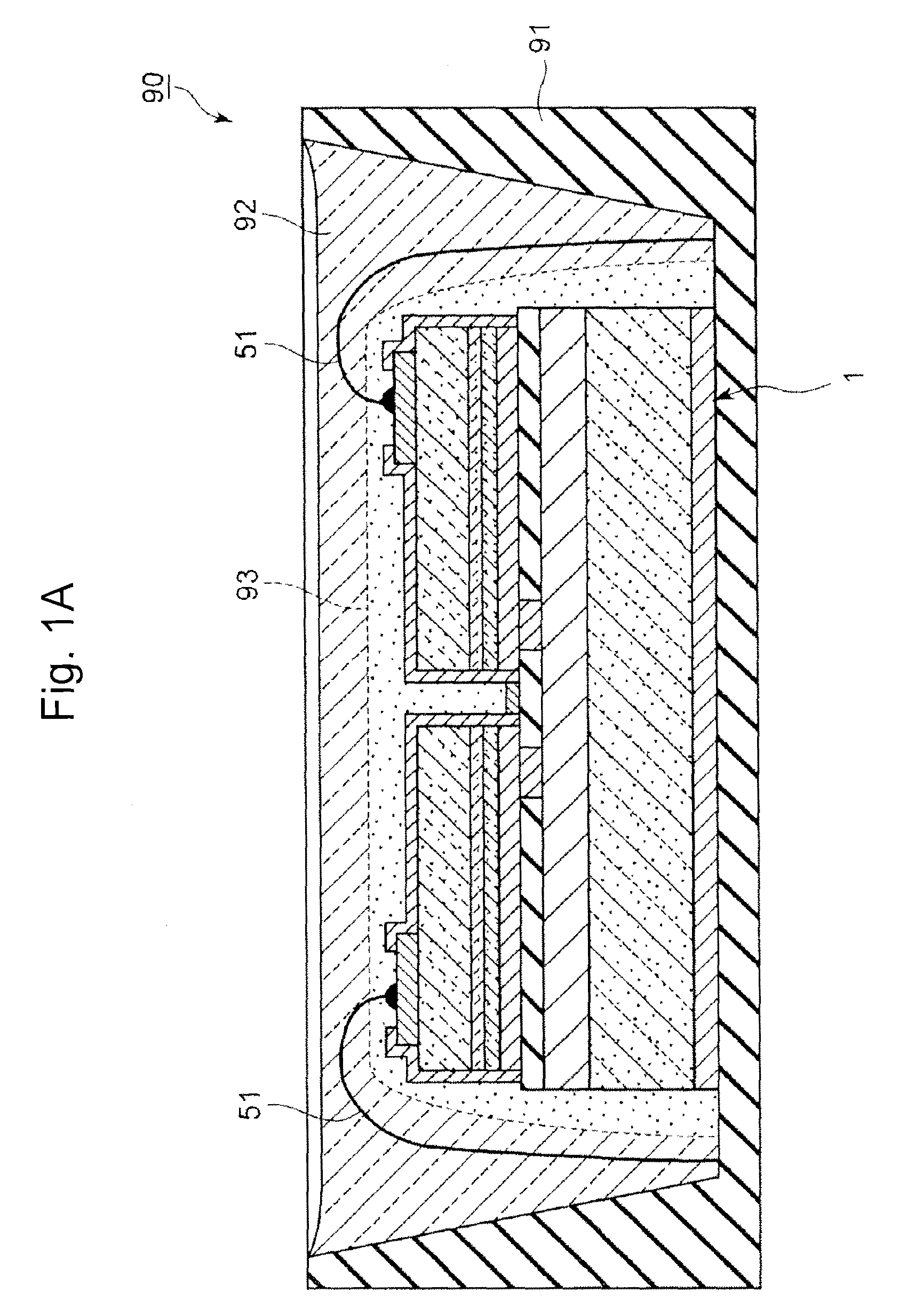Semiconductor light emitting device
a technology of light-emitting devices and semiconductors, which is applied in the manufacture of semiconductor/solid-state devices, semiconductor devices, electrical devices, etc., can solve the problems of wasting acceptable regions, generating more likely defective regions, and reducing so as to improve light extraction efficiency, shorten the average distance traveled, and reduce the number of reflections of light
- Summary
- Abstract
- Description
- Claims
- Application Information
AI Technical Summary
Benefits of technology
Problems solved by technology
Method used
Image
Examples
first embodiment
[0061]FIGS. 1A to 1C illustrate a semiconductor light emitting device 90 of the present embodiment. The semiconductor light emitting device 90 includes a semiconductor light emitting element 1 mounted in a recess of a housing 91, and a transparent sealing resin 92 covering the semiconductor light emitting element 1. The transparent sealing resin 92 contains fluorescent particles 93 (i.e., “first fluorescent particles”), and is deposited around the semiconductor light emitting element 1. While the fluorescent particles 93 are depicted as spherical particles in FIGS. 1B and 1C, the fluorescent particles 93 are not necessarily spherical. For example, the fluorescent particles 93 may be irregularly shaped. Regardless of its shape, each of the fluorescent particles has an individual average particle diameter.
[0062]FIGS. 2A and 2B illustrate the semiconductor light emitting element 1. The semiconductor light emitting element 1 includes a junction layer 20, a protective film 80, a reflecti...
second embodiment
[0126]The present embodiment differs from the first embodiment in that the reflection layer 30 is formed up to the bottom 2b of the trench 2 (see FIG. 8). When the reflection 30 is formed of material or the like that is unlikely to migrate, the present modified embodiment is preferable. The reflection layer 30 whose reflectivity is generally higher than that of a dielectric multilayered film allows the light directed toward the bottom 2b of the trench 2 to be effectively reflected and emitted toward the outside of the trench 2. Thus, the formation of the reflection layer 30 up to the bottom 2b of the trench 2 can further improve the light extraction efficiency of the semiconductor light emitting element 1.
[0127]When manufacturing the semiconductor light emitting element 1 of the present embodiment, “(8) region separation step (see FIG. 5I)” of the manufacturing method disclosed in the first embodiment is modified. Specifically, when the trench 2 is formed in the semiconductor lamina...
third embodiment
[0128]The present embodiment differs from the first embodiment in that only the protective film 80 is provided between the support substrate and the semiconductor laminate without providing the reflection layer 30 (see FIG. 9). In the same manner as in the first embodiment, the protective film 80 can also be provided at the bottom 2b of the trench 2. When the material for the reflection layer 30 is likely to migrate, or when the reflection layer 30 is disadvantageously likely to diffuse into the semiconductor laminate 40, the reflection layer 30 is preferably not formed. The formation of the protective film 80 using a dielectric multilayered film instead of the reflection layer 30 permits the light to be reflected from the semiconductor laminate 40 toward the support substrate 10 and thus can suppress the absorption of the light. The inclusion of the protective film 80 formed of the dielectric multilayered film can keep the intensity of light transmitted through the semiconductor la...
PUM
 Login to View More
Login to View More Abstract
Description
Claims
Application Information
 Login to View More
Login to View More - R&D
- Intellectual Property
- Life Sciences
- Materials
- Tech Scout
- Unparalleled Data Quality
- Higher Quality Content
- 60% Fewer Hallucinations
Browse by: Latest US Patents, China's latest patents, Technical Efficacy Thesaurus, Application Domain, Technology Topic, Popular Technical Reports.
© 2025 PatSnap. All rights reserved.Legal|Privacy policy|Modern Slavery Act Transparency Statement|Sitemap|About US| Contact US: help@patsnap.com



